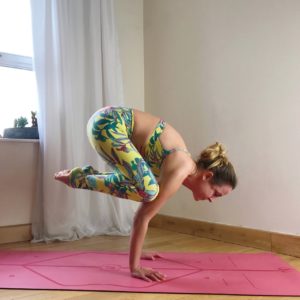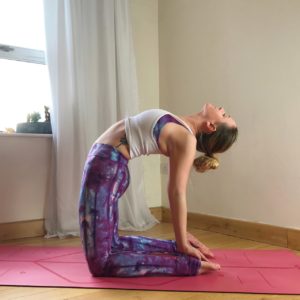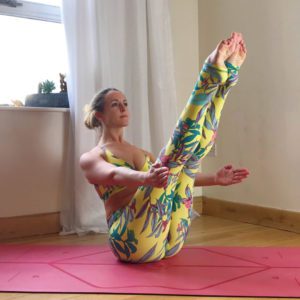“I wish I had enough time for yoga.” How many times have you heard those words, or said them yourself?
Something that I get asked about on a regular basis is how I’m able to keep the balance between a demanding career and a dedicated yoga practice. These questions come from both people that I work with, and people that I practice with. I am a medical doctor, specializing in obstetrics & gynaecology (OB/GYN), and my Ashtanga practice has me learning Intermediate Series. One thing that often prevents people from dedicating themselves to a daily practice is the perceived impossibility of fitting it into their already-crammed schedule. Certainly, before I started practicing yoga, I wondered how people had time for work, physical activities, volunteering, and socializing. These super-human individuals seemed to have more hours in the day than the rest of us mere mortals. I added yoga to my life over three years ago, from a previously sedentary and unhealthy lifestyle. Having seen both sides of the coin, I can tell you that it’s not possible to invent more hours in the day. That said, it is completely possible to manage a busy career and a demanding practice.
As the yoga practice took hold in my mind and soul, what had been a weekly exercise became a daily practice. This process evolved over the course of about a year. I noticed that the more time I committed to yoga, the less time I devoted to other things. This natural evolution in my priorities is something that is ongoing. Going out for a big night isn’t something that interests me much anymore. Neither does staying up to date on the latest episode of Queer Eye. Don’t get me wrong; I don’t think there’s anything wrong with these things. Rather, I moved them down my list of priorities so far that they rarely happen anymore. Other things became more important: yoga, work, and a small circle of loved ones. One of the benefits of starting a physical practice from a place of inactivity is the abundance of new energy that comes along with it. So, while you might not be able create more hours in the day, you might be able to do more in the hours that are given to us. Prior to committing to a daily practice, I would often feel sluggish after work. Now, I look forward to getting on the mat, be it at home or in the shala.

Along with working long hours, I also work unusual, irregular hours. This is something that I have learned to embrace. I get to be quite creative in my practice schedule. An Ashtanga practice lends itself well to this sort of flexibility of schedule. Did I really just say that, about the style of yoga most known for its disciplined structure? In a word, yes. However, I am forced to veer away from what tradition dictates, which is early-morning practice, 6 days a week. Evening practice suits me better, and is more sustainable for me. I often swap around moon days, which are meant to be days of rest, for other days to accommodate my schedule. Most importantly, I have a sequence that I can do anytime and anywhere, and there is power in that. If I’m in work until 9 pm, I can come home and do as much of my practice as I’m able for. If I’m doing one of my 24-hour-long, in-hospital shifts, I might get a chance to do a Surya Namaskar or two in the on-call room. Working a night shift? Get on the mat at home or in the shala in the morning.
In addition to learning to be flexible with the times that I practice, I’ve expanded my definition of what practice is. Working in my career, I am regularly expected to be awake (and functioning!) for 24 hours in a go. This usually involves long hours standing, and doing physical work on my feet. These things naturally take a toll on my body. Some days my body is only able for the Surya Namaskar and the finishing postures. Other days, a full-power, long practice is what I need. Most days, it’s somewhere in between. In my early days of practicing Ashtanga, I would beat myself up if I didn’t have the capacity for a full practice everyday. I pushed and pushed, often to the point of injury. My type-A personality and need to achieve were something I had to confront on the mat. Learning to accept my limitations, and accept where I am any given day, has brought me a lot of peace. There will always be ebbs and flows of busy times at work and softer practices, to balance with less busy times and more energetic practices. It’s all practice!

I’ve talked a lot about the physical practices of yoga, but that’s not all there is to yoga. Within the 8 limbs of yoga, we also have codes of conduct and personal disciplines, the yamas and niyamas. Applying these ethical guidelines to our day-to-day life is another important way of practicing yoga. I also like to think of my work as a form of karma yoga. That is, good work, done unselfishly, to benefit another, is a form of prayer. While I’ve written mostly on navigating the often-negative impact that a busy career can have on a yoga practice, there is a lot to be said for the impact that the practice has on career. In yoga practice, we are continuously being confronted by difficult situations, and are asked to sit with them. This brings up our stuff, whatever that may be. This can have manifold benefits. By unpacking our own demons, and challenging our habitual patterns of thinking, it’s natural to become more compassionate towards others. That pose that challenges us immensely might bring up anger, frustration, or sadness. We can now see that when someone at works acts in an unpleasant manner, they are really reacting to something within themselves. In knowing that, it is easier to address the negative behavior, and forgive the person. This way of thinking has changed the way I interact with colleagues and patients alike, for the better.
I’ve also learned to extend this kindness and compassion, and what is essentially ahimsa, to myself too. Being more in tune with the body and mind has made me realize how badly I was – and often still am – abusing both in the name of work. Inadequate sleep, poor diet, less than ideal posture, negative self talk. All these things can easily happen when we put career first. However, the yoga practice continuously brings my awareness back to these habits, and challenges me to change them. Through the yoga practice, we become more resilient, and able to recover from failures. How many times have we failed on that difficult posture, only to try again tomorrow? Difficult situations arise in my line of work frequently, and being resilient is essential. Being present, empathetic, and kind in stressful situations are skills that can be learned. Being able to not become attached to the situation is often more difficult, but yoga helps us practice that. My way of approaching the yoga practice won’t work for everyone or every job. They are simply the things that I have learned over time. Hopefully something I’ve shared can help someone out there struggling to find time for the mat.
Namaste.
By Alison DeMaio
Alison is a medical doctor, specialising in obstetrics and gynaecology in one of Ireland’s leading maternity hospitals. Originally from the Bluegrass state of Kentucky, she earned a bachelor’s degree in Biological Sciences in 2007. The following year she moved to Dublin where she completed a graduate medical degree at the Royal College of Surgeons in Ireland. In her early years of working as a doctor, Alison experienced a great deal of back pain and stress. Yoga became a deeply transformative tool in both her physical and emotional healing. Alison is committed to her daily Ashtanga Mysore practice, despite the demands of a busy job. She has been fortunate to practice with some world-renowned teachers, and she is currently learning the Ashtanga Intermediate Series in the traditional method. Keep in touch with Alison (@ashtangi_ali) on Instagram.










